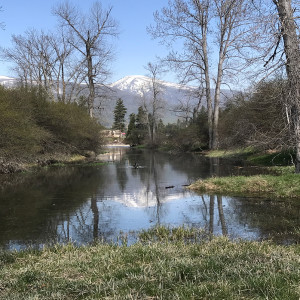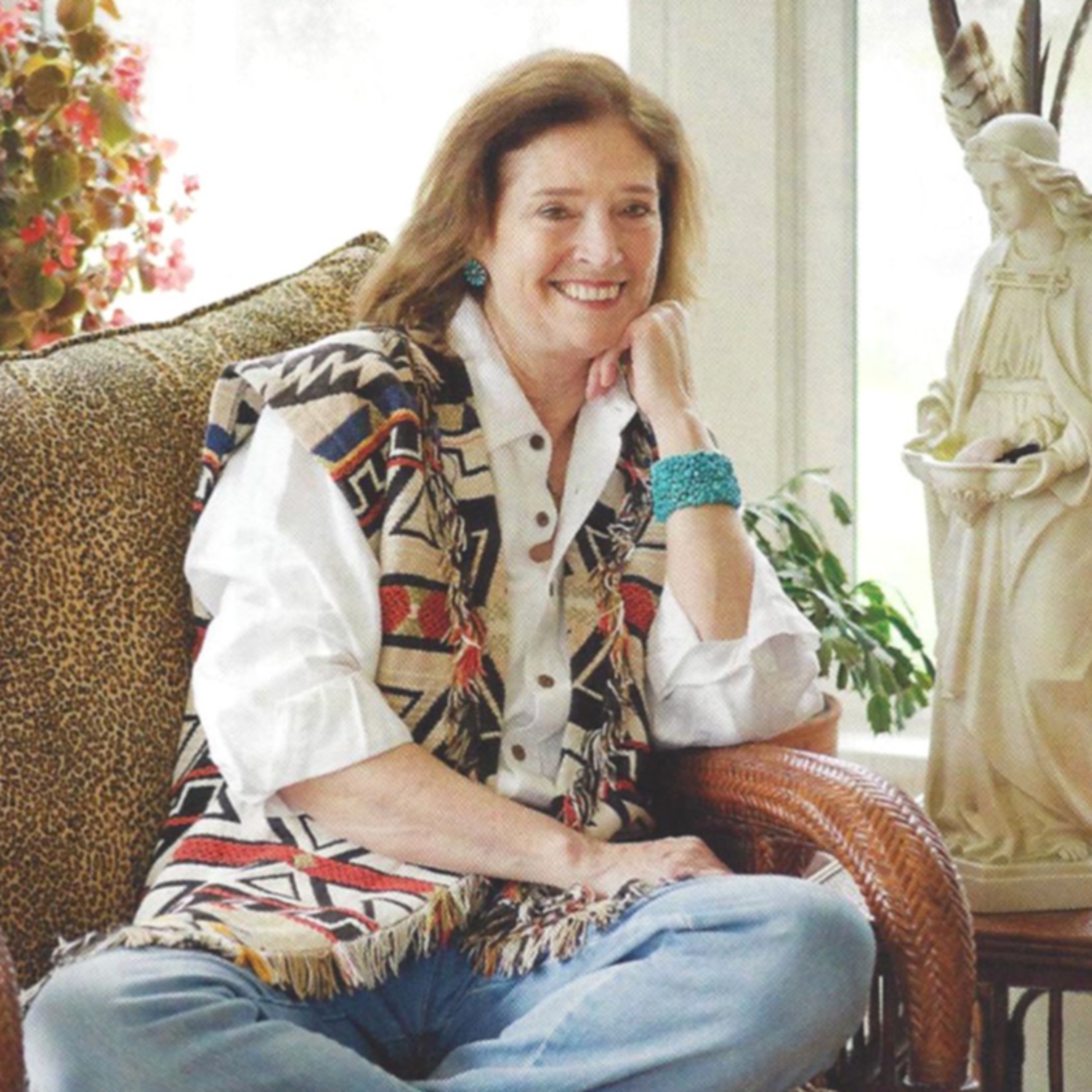Episodes

Wednesday Dec 05, 2018
God's Divine Wisdom and Myla's Mission: Mystic Grace Podcast #12
Wednesday Dec 05, 2018
Wednesday Dec 05, 2018
“Howdy!” from the Bitterroot Valley of Stevensville in Western Montana and the Fort Owen Ranch. It is Thanksgiving week and we are in great preparation for a crowd of family and friends that will descend on the ranch in the next few days.
It is so much fun for me to visit here and to be a part of Myla’s First Thanksgiving in her “new” historic home on a live working cattle ranch.
It’s also a beautiful time to be in Montana as this good friend of mine, Myla Yahraus, is taking me on a Sunday drive right through her 600+ acre property down to the sparkling Bitterroot River.
For my twelfth podcast, I have invited Myla to talk about her plans for the ranch, her vision quest and what has happened since she bought the ranch one year ago.
We open gates and close them and watch white tailed deer sprinting across the fields, cattle and horses grazing out in the pastures and the snow covered Bitterroot Mountain Range glittering a short distance away.
The tallest peak is called St. Mary’s Peak by the Salish Indians who have considered it a sacred place for vision quests. According to historical documents and journals, these peaceful interactive Indians were the Bitterroot Valley’s “first people” who invited the “black robes” the Jesuits, to come to their homeland and teach them about the salvation of God.
It took many years and four emissaries for that to happen, but finally in 1841, the first white settlement was built and established as the first Christian/Catholic missionary in Montana. It lasted 9 years before its abandonment and sale to Maj. John Owen who bought the property in 1850 and renamed it after himself. ** See story below.
Maj. Owen had quite the entrepreneurial spirit and ethics to develop the region and make Ft. Owen a successful trading post. He proved to be an outstanding trader/ pioneer, master builder and friend to all. Trusted by the Indians as well as the whites, his word was always good. John Owen was also married to a Shoshone Indian woman known as “Nancy” whom he cherished all of his life.
A well respected negotiator and Indian agent, he was famous for his philosophy, hospitality and holiday feasts.
And here we are, 168 years later, preparing for another thanksgiving feast!
Driving through the river bottom to get to the edge of the river, we are wondering if we are going to get stuck. But Myla’s big diesel F-350 truck and our laughter should see us to our destination. Besides, there’s always Kent, her devoted ranch manager and quite the entrepreneur himself, who would come to pull us out.
I record the sound of the rushing creek and we sit in her truck by the river honoring the vision of what we see before us, God’s Love, for her dream.
As her story begins, she reminds me of Mark Batterson’s book, “Chase the Lion” in which he proclaims “If your dream doesn’t scare you, it isn’t big enough!”
After the death of her beloved husband of 37 years in Las Vegas, Nevada, Myla undergoes eye surgery and contemplates what she is going to do for the next twenty years. She wants to “do something for God.” As her eyes are wrapped in bandages, listening to her dear friend Jackie read to her, she yearns to find a peaceful place for her soul to live and teach. Resting in the darkness, she begins to “see” and feel what God is envisioning for her. She is going to build a trade/vocational school for young adults. She will find the place, the teachers, the tinkerers and the students. She will be happy to start with just 12 young adults.
Joined by other spirited pioneers who feel called into her vision as well, Myla forms a mission statement based on the principles of “Faith, Family, Freedom,
& Free Enterprise.” Soon, the Fort Owen Foundation will be set up and a trade school established especially for the youth of America who seem really lost out there on the trail.
Myla feels that America’s soul is on “life support” these days and feels strongly in her need to share her confidence and conviction that when we find ourselves in the darkness, lost and sometimes utterly despondent, we just have to ask God to help us. The truth is that we are not alone and never will be. If you follow your heart & follow your dreams, it opens the mountains and the streams, it opens the windows to the Light of God’s promise for US.
Thank you Myla, “first lady of the fort” for your great vision quest and Kent, for his God-given talent and heart’s desire to run a ranch; for their family and
friends who are helping now and for those who will pick up the trail for this great mission in the near future.
You have answered God’s call from the sacred Bitterroot mountains and that of St. Mary’s Peak. The new missionaries have arrived and the vision quest begun. See you at the ranch!
**The story of St. Mary's Mission begins in 1823, when twelve Iroquois, employed as trappers by the Hudson's Bay Company, remained with the Salish through the winter of 1823-24. Exposed to Christianity 200 years previous, they told the Salish stories of Christianity and of the "Black Robes", the missionaries who taught them. The Salish proved to be an interested audience and, between 1831 and 1839 they sent four delegations to St. Louis in an attempt to obtain a Black Robe of their own. On September 24, 1841, Father Pierre Jean DeSmet, together with his fellow Jesuit missionaries, Fathers Gregory Mengarini and Nicolas Point, and three Lay Brothers arrived in the Bitterroot Valley with their belongings and supplies in three carts and a wagon, the first vehicles to enter the area. They established the first white settlement in what was to become Montana, on the east bank of the Bitterroot River, immediately west of the present town of Stevensville.
The fathers built two chapels, residences and outbuildings, and began farming, planting wheat, oats, potatoes and garden crops. From Fort Vancouver they brought into Montana the first cattle, swine and poultry. A third chapel was under construction by 1846 but soon trouble with the Blackfeet forced the closure of the mission, the entirety being sold in November 1850 to John Owen, a former army sutler, for $250.00. John Owen was born in Pennsylvania June 27, 1818. He was 31 when he came to the fort. Nancy - Owen’s Indian wife - was to all appearances considerably older than he. She was a diminutive woman, scarcely five feet high, and in her later years, at least, with a very wrinkled face. She had no children. Nancy was an indefatigable worker; was unquestionably deeply attached to Owen and so far as was possible clung to certain ingrained Indian traits in spite of her position. She took little or no part in festivities; devoted her waking hours to fishing, berry-picking, cooking, or other toils, and at night took her blanket, rolled up in it, and slept on the ground or some floor apart from the remainder of the Fort’s population. She accompanied Owen on several of his expeditions, and on such occasions apparently did a man’s work. Eight years after the beginning of their relationship Owen made a formal statement of marriage with her. He was deeply concerned whenever she was ill, gave her every care that was possible; and at her death was profoundly affected. His whole attitude toward his Indian squaw was unusual when compared with the ordinary association of the kind.


No comments yet. Be the first to say something!